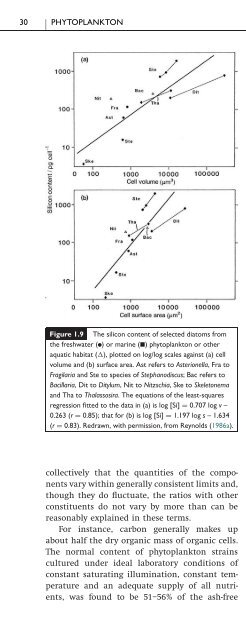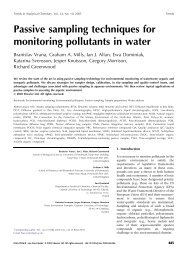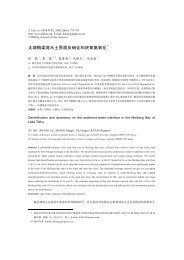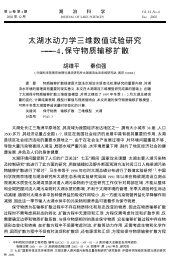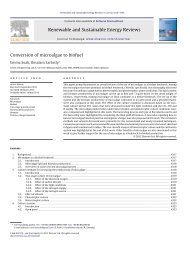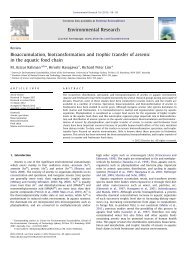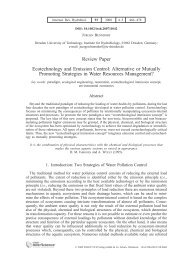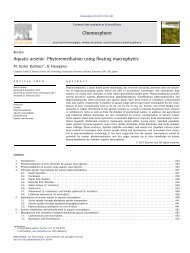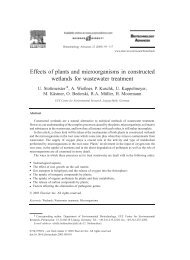- Page 2:
This page intentionally left blank
- Page 6:
ecology, biodiversity, and conserva
- Page 10:
cambridge university press Cambridg
- Page 16:
Contents Preface Acknowledgements p
- Page 20:
References Index to lakes, rivers a
- Page 26:
xii PREFACE questions the very conc
- Page 30:
Acknowledgements Except where state
- Page 34:
2 PHYTOPLANKTON In this way, plankt
- Page 38: 4 PHYTOPLANKTON ecosystems, Hensen
- Page 42: 6 PHYTOPLANKTON Table 1.1 Survey of
- Page 46: 8 PHYTOPLANKTON Table 1.1 (cont.) P
- Page 50: 10 PHYTOPLANKTON Table 1.1 (cont.)
- Page 54: 12 PHYTOPLANKTON of producing popul
- Page 58: 14 PHYTOPLANKTON The relatively rec
- Page 62: 16 PHYTOPLANKTON reveals a commensu
- Page 66: 18 PHYTOPLANKTON mechanisms for inc
- Page 70: 20 PHYTOPLANKTON Table 1.2 Nominal
- Page 74: 22 PHYTOPLANKTON Notes to Table 1.2
- Page 78: 24 PHYTOPLANKTON attenuated cells (
- Page 82: 26 PHYTOPLANKTON Table 1.3 Air-dry
- Page 86: 28 PHYTOPLANKTON Volcani, 1981). In
- Page 92: THE CONSTRUCTION AND COMPOSITION OF
- Page 96: THE CONSTRUCTION AND COMPOSITION OF
- Page 100: Table 1.7 Some cell measurements of
- Page 104: (who invented the name ‘plankton
- Page 108: Table 2.1 Comparison of the physica
- Page 112: slippage of another across it, for
- Page 116: Figure 2.3 The currents at the surf
- Page 120: Figure 2.5 The generation of turbul
- Page 124: those driven by surface wind stress
- Page 128: is that the individual organisms ar
- Page 132: constant increases sinking velocity
- Page 136: phytoplankton and the role of form
- Page 140:
density (∼1005 kg m −3 )would s
- Page 144:
ADAPTIVE AND EVOLUTIONARY MECHANISM
- Page 148:
etween their assembly and their col
- Page 152:
ADAPTIVE AND EVOLUTIONARY MECHANISM
- Page 156:
Figure 2.12 Plot of sinking rates (
- Page 160:
Figure 2.14 Plot of sinking rates o
- Page 164:
they create a local change in the m
- Page 168:
matters to sinking particles is the
- Page 172:
left the same layer had it been unm
- Page 176:
The effect of wind is to distribute
- Page 180:
Figure 2.19 Depth, H, plotted again
- Page 184:
stratified enclosure during relativ
- Page 188:
Moreover, the biological differenti
- Page 192:
thermal stratification (usually in
- Page 196:
may result in discontinuous vertica
- Page 200:
generation time (Reynolds, 1986b).
- Page 204:
Figure 2.28 Whole-lake ‘conveyor
- Page 208:
the most probable cases having a cr
- Page 212:
is damped and dissipated through a
- Page 216:
Chapter 3 Photosynthesis and carbon
- Page 220:
ibulose 1,5-biphosphate (RuBP) reac
- Page 224:
are rather loosely dispersed throug
- Page 228:
the carbon fixed. To evaluate these
- Page 232:
plankters in their natural environm
- Page 236:
The decline in biomass-specific P b
- Page 240:
product Pmax × (the depth from the
- Page 244:
Figure 3.6 Mean saturated chlorophy
- Page 248:
time courses of insolation, measure
- Page 252:
Figure 3.10 The absorption of visib
- Page 256:
Figure 3.12 Carbon-specific area of
- Page 260:
which project perhaps 10-30 m 2 (mo
- Page 264:
LIGHT-DEPENDENT ENVIRONMENTAL SENSI
- Page 268:
photosynthesis is possible (hp), th
- Page 272:
Figure 3.16 Growth-rate responses o
- Page 276:
and larger, buoyancy-regulating Cya
- Page 280:
Figure 3.17 The pH-carbon dioxide-c
- Page 284:
may be equally diminished on a rela
- Page 288:
nitrogen and phosphorus in particul
- Page 292:
CAPACITY, ACHIEVEMENT AND FATE OF P
- Page 296:
CAPACITY, ACHIEVEMENT AND FATE OF P
- Page 300:
CAPACITY, ACHIEVEMENT AND FATE OF P
- Page 304:
CAPACITY, ACHIEVEMENT AND FATE OF P
- Page 308:
CAPACITY, ACHIEVEMENT AND FATE OF P
- Page 312:
CAPACITY, ACHIEVEMENT AND FATE OF P
- Page 316:
substrates, even though they turn o
- Page 320:
Chapter 4 Nutrient uptake and assim
- Page 324:
Here, the movement of solutes are s
- Page 328:
Figure 4.3 Basic structure of a rec
- Page 332:
deployment and growth. At low but s
- Page 336:
as fluorapatite and hydroxylapatite
- Page 340:
developed, the understanding of pho
- Page 344:
PHOSPHORUS 157 Table 4.2 Some speci
- Page 348:
of the cells. According to the expe
- Page 352:
Figure 4.6 (a) Observed maximum chl
- Page 356:
Vibrio, first reducing nitrate to n
- Page 360:
intracellular anaerobic conditions
- Page 364:
or participate in its function. Som
- Page 368:
incidental confirmation of the proc
- Page 372:
independent of an external supply.
- Page 376:
In the context of sulphur biogeoche
- Page 380:
45% of the mass of siliceous debris
- Page 384:
In parts of the Atlantic and Indian
- Page 388:
of 2(ln2= 0.693) and its relation t
- Page 392:
Assembling the growing cell has bee
- Page 396:
measured rates of change in numbers
- Page 400:
Figure 5.2 Maximum growth and repli
- Page 404:
Figure 5.3 Temperature dependence o
- Page 408:
(0.151 × 0.63 × 10 −12 =) 0.095
- Page 412:
Figure 5.4 Light dependence of grow
- Page 416:
are located so relatively deep in t
- Page 420:
could be true at MRP concentrations
- Page 424:
through observation and experiment.
- Page 428:
in physiological variability in N :
- Page 432:
Figure 5.7 Initial increase in cell
- Page 436:
REPLICATION RATES UNDER SUB-IDEAL C
- Page 440:
systems), a few days (polymictic an
- Page 444:
actual depth through which growth-s
- Page 448:
There are probably sufficient data
- Page 452:
of their ecologies. The C-S gap is
- Page 456:
(Section 6.3). Representative gener
- Page 460:
No physical change occurs (they do
- Page 464:
increase the probability of surviva
- Page 468:
GROWTH OF PHYTOPLANKTON IN NATURAL
- Page 472:
GROWTH OF PHYTOPLANKTON IN NATURAL
- Page 476:
the year. The narrowness of the 95%
- Page 480:
Figure 5.14 Reynolds’ (1997b) pro
- Page 484:
Figure 5.15 Approximations of the d
- Page 488:
terrestrial replenishment (Fig. 5.1
- Page 492:
the water was clear and the ratio o
- Page 496:
y colonial Chlorophyceae (CS strate
- Page 500:
do different things. These may be i
- Page 504:
(and are sometimes well within) the
- Page 508:
Chapter 6 Mortality and loss proces
- Page 512:
at t, then, at t2, weshould have: N
- Page 516:
y filter-feeding zooplankton and (s
- Page 520:
non-saline inland waters (ρw) is l
- Page 524:
Figure 6.3 Net increase and attriti
- Page 528:
6.3.3 Accumulation and resuspension
- Page 532:
and ecology of particular zooplankt
- Page 536:
Table 6.1 (cont.) CONSUMPTION BY HE
- Page 540:
Table 6.1 (cont.) CONSUMPTION BY HE
- Page 544:
Table 6.1 (cont.) CONSUMPTION BY HE
- Page 548:
and where feeding relies mainly on
- Page 552:
Holopedidae are represented by a si
- Page 556:
2003). Equally, the growth of micro
- Page 560:
Quantitatively, the best studied of
- Page 564:
Possibly the most pertinent deducti
- Page 568:
Thompson et al. (1982) found that t
- Page 572:
Box 6.1 On the sticky question of m
- Page 576:
CONSUMPTION BY HERBIVORES 273 quick
- Page 580:
d = 26 µm). These increases were n
- Page 584:
CONSUMPTION BY HERBIVORES 277 Table
- Page 588:
carnivorous in the later copepodite
- Page 592:
CONSUMPTION BY HERBIVORES 281 Box 6
- Page 596:
CONSUMPTION BY HERBIVORES 283 Some
- Page 600:
CONSUMPTION BY HERBIVORES 285 Table
- Page 604:
although the authors noted that nei
- Page 608:
native species and a greater variet
- Page 612:
Food-chain length The examples give
- Page 616:
The most conspicuous fungal parasit
- Page 620:
presumably, to facilitate transfer
- Page 624:
are probably exaggerated. However,
- Page 628:
prevents it from increasing at all
- Page 632:
esource that is available to direct
- Page 636:
SPECIES COMPOSITION AND TEMPORAL CH
- Page 640:
Even the permanent pycnocline, loca
- Page 644:
of the Kuroshio Current (roughly, f
- Page 648:
The Coriolis forces acting on the f
- Page 652:
though this is under way at least a
- Page 656:
eutrophication from its main influe
- Page 660:
Figure 7.3 The ‘intaglio’ (of S
- Page 664:
to the Prochlorococcus-dominated am
- Page 668:
phytosociologists to diagnose plant
- Page 672:
Table 7.1 (cont.) SPECIES COMPOSITI
- Page 676:
over fixed carbon to the microbial
- Page 680:
calmer conditions, the Cyanobacteri
- Page 684:
et al., 1997). Originally identifie
- Page 688:
SPECIES COMPOSITION AND TEMPORAL CH
- Page 692:
SPECIES COMPOSITION AND TEMPORAL CH
- Page 696:
All these lakes can support signifi
- Page 700:
its dynamics coincide sufficiently
- Page 704:
and Black Sea watersheds in that co
- Page 708:
(C/D/Y → X1/X2/Y/E → H1/F → L
- Page 712:
of the intensification of the therm
- Page 716:
On this basis, some ‘large lakes
- Page 720:
Finally, many shallow, hypertrophic
- Page 724:
Table 7.6 Sensitivities to habitat
- Page 728:
Figure 7.8 (a) Habitat template for
- Page 732:
matter, cohabitant microbes, zoopla
- Page 736:
point that needs to be emphasised i
- Page 740:
over a12-year period, Venrick (1990
- Page 744:
adiation (Qs) as heat (units, W m
- Page 748:
an attendant increase in transparen
- Page 752:
Table 7.7 Attributes of early and m
- Page 756:
Figure 7.14 Idealised environments,
- Page 760:
intense is the competition for the
- Page 764:
Figure 7.17 Periodicity of dominant
- Page 768:
against Hardin’s (1960) principle
- Page 772:
various states of ecological disequ
- Page 776:
weather conditions (hurricanes, flo
- Page 780:
in Connell’s (1978) hypothesis an
- Page 784:
duration and the physiological resi
- Page 788:
Figure 7.24 Annual mean Shannon div
- Page 792:
the 100 or so commonly encountered
- Page 796:
independently of which species had
- Page 800:
similarity of seasonal pattern amon
- Page 804:
Chapter 8 Phytoplankton ecology and
- Page 808:
is suggested to be 5-80 mg C m −3
- Page 812:
the turnover of carbon than nutrien
- Page 816:
the order 1-10 g Cm −2 . Larger c
- Page 820:
/ / Processing fluxes Figure 8.2 Lo
- Page 824:
Figure 8.4 Sketch to show several a
- Page 828:
systems in general. Reynolds and Da
- Page 832:
Table 8.1 Proposed criteria for cla
- Page 836:
et al., 1964). The work was continu
- Page 840:
generate a toxic dose in 28 L of la
- Page 844:
implicit confidence in the techniqu
- Page 848:
Figure 8.7 Stages in the recovery o
- Page 852:
stage 1 to a P-led biomass reductio
- Page 856:
through their physical penetration
- Page 860:
supportable concentration is closer
- Page 864:
efficient traits (discussion in Sec
- Page 868:
associated with a strong presence o
- Page 872:
epiphytic and some planktic algae t
- Page 876:
state has become too firmly establi
- Page 880:
phytoplankton, tolerance of natural
- Page 884:
eplacement by ‘sea urchin barrens
- Page 888:
Starting with what we know, the glo
- Page 892:
carbon-exporting elements of the pe
- Page 896:
state, a low, stable, average bioma
- Page 900:
50% of the area is
- Page 904:
Glossary Text boxes are used to exp
- Page 908:
eflection, absorption or consumptio
- Page 912:
L litre, a customary unit of volume
- Page 916:
Rib bulk Richardson number, being t
- Page 920:
z(0.5I k) depth beneath the water s
- Page 924:
References Abeliovich, A. and Shilo
- Page 928:
Productivity, ed. P. J. leB. Willia
- Page 932:
Bowen, C. C. and Jensen, T. E. (196
- Page 936:
(1980). Some general observations o
- Page 940:
shallow lake, with special referenc
- Page 944:
Sensing, ed.F.M. Danson and S. E. P
- Page 948:
Algal Blooms, ed.D. M. Anderson, A.
- Page 952:
(2002). Global dispersal of free-li
- Page 956:
(2002). Regional scale influences o
- Page 960:
northern pike, aquatic vegetation a
- Page 964:
Heaney, S. I., Canter, H. M. and Lu
- Page 968:
Huisman, J. and Sommeijer, B. (2002
- Page 972:
on growth and sinking rate of two p
- Page 976:
Kierstead, H. and Slobodkin, L. B.
- Page 980:
y various predators. Microbial Ecol
- Page 984:
Levich, A. P. (1996). The role of n
- Page 988:
Lund, J. W. G., Kipling, C. and Le
- Page 992:
(1987). Trophic dynamics and develo
- Page 996:
organisms in a hypereutrophic pond.
- Page 1000:
Owens, O. van H. and Esaias, W. (19
- Page 1004:
(1999). Spatial structure of pelagi
- Page 1008:
composition of plankton. In The Jam
- Page 1012:
(2000a). Phytoplankton designer or
- Page 1016:
Richey, J. E., Melack, J. M. Aufdem
- Page 1020:
Sarmiento, J. L. and Wofsy, S. C. (
- Page 1024:
Sirenko, L. A., Stetsenko, N. M., A
- Page 1028:
Spencer, M. and Warren, P. H. (1996
- Page 1032:
(1957a). Diurnal changes of stratif
- Page 1036:
growth rate of Microcystis (Cyanoba
- Page 1040:
Walsby, A. E., Utkilen, H. C. and J
- Page 1044:
Microcystis aeruginosa hyperscums f
- Page 1048:
Lowes Water, UK 54 ◦ 34 ′ N, 3
- Page 1052:
Index to genera and species of phyt
- Page 1056:
Chromulina (Chrysophyta CHROMULINAL
- Page 1060:
Glaucocystis (Glaucophyta) F6 Table
- Page 1064:
Peridinium gatunense Nygaard F, LO
- Page 1068:
Synedra ulna (Nitzsch) Ehrenb. F, B
- Page 1072:
Daphnia galeata 221, 261, 266, 266
- Page 1076:
Tropocyclops Crustacea, Cyclopoidea
- Page 1080:
own tides, 407 bryophytes, 11 bryoz
- Page 1084:
‘swimming’ velocities, 68; vita
- Page 1088:
keystone species, 382, 394, 427 kin
- Page 1092:
particulate organic matter (POM), 3
- Page 1096:
quantum yield of photosynthesis, 98
- Page 1100:
vertical migration of phytoplankton


